Mammillaria baumii was first described by Friedrich Boedeker and published in Zeitschrift für Sukkulentenkunde in 1926.
Scientific Name
Mammillaria baumii Boed.
Synonym(s)
Dolichothele baumii, Ebnerella baumii
Scientific Classification
Family: Cactaceae
Subfamily: Cactoideae
Tribe: Cacteae
Subtribe: Cactinae
Genus: Mammillaria
Etymology
The specific epithet "baumii" (pronounced BAWM-ee-eye) honors Hugo Baum (1867-1950), a German botanist.
Origin
Mammillaria baumii is native to Mexico. It grows on rocky hills under bushes in Tamaulipas at elevations between 2,300 and 5,910 feet (700 and 1,800m).
Description
Mammillaria baumii is a small cactus that grows in clusters of spherical to egg-shaped stems almost entirely hidden by bristle-like spines. The stems can grow up to 2.8 inches (7 cm) tall and 2.4 inches (6 cm) in diameter. They have cylindrical to conical tubercles tipped with a white-felted areole bearing a cluster of spines. Each areole bears 5 to 11 central and 30 to 50 radial spines. The central spines are whitish-yellow and can measure up to 0.7 inches (1.8 cm) long, while the radial spines are white and can measure up to 0.6 inches (1.5 cm) long. The axils of the tubercles are woolly in young plants but quickly become naked.
In late spring, Mammillaria baumii produces fragrant flowers with bright yellow inner tepals and greenish or brownish-yellow outer tepals with a pink tinge. The flowers are funnel-shaped and can reach a length of 1 inch (2.5 cm) and a diameter of 1.2 inches (3 cm). The fruits are grayish-green, oblong to ovoid, and can grow up to 0.6 inches (1.5 cm) long and 0.55 inches (1.1 cm) in diameter. They contain dark brown seeds.

How to Grow and Care for Mammillaria baumii
Light: For optimal growth of your Mammillaria baumii, ensure it is planted in an area that receives at least four hours of direct sunlight daily. If growing indoors, placing the cactus near a bright window is best to ensure it gets enough light. It is advisable to keep it on the balcony or in the garden from spring to fall for additional light.
Soil: To ensure good root aeration and drainage, use commercial cactus soil or create your own well-draining soil mix.
Temperature: Mammillaria baumii is heat tolerant but is not a cold-hardy plant. It grows best in USDA Plant Hardiness Zones 9b to 11b, with average minimum winter temperatures ranging from 25 to 50 °F (-3.9 to 10 °C).
Watering: Water deeply from spring to fall, and wait until the soil dries out before watering again. Never let your pot sit in water, and suspend watering when the plant goes dormant in the winter.
Fertilizing: During the growing season, Mammillaria baumii benefits from fertilizing. Apply a water-soluble fertilizer for cacti and other succulents. Suspend feeding during the winter when the plant goes dormant.
Repotting: Repot the cactus into a slightly larger pot every two or three years, preferably during late winter or early spring. However, repotting can be done at any time of the year.
Propagation: There are two easy ways to propagate Mammillaria baumii: by seeds or by dividing offsets. The best time to remove offsets is in spring and summer. Sow the seeds in late spring or summer for the best results.
Learn more at How to Grow and Care for Mammillaria.
Toxicity of Mammillaria baumii
Mammillaria baumii is non-toxic but has sharp spines, so keep it away from children and pets.
Links
- Back to genus Mammillaria
- Succupedia: Browse succulents by Scientific Name, Common Name, Genus, Family, USDA Hardiness Zone, Origin, or cacti by Genus
Photo Gallery
Click on a photo to see a larger version.


